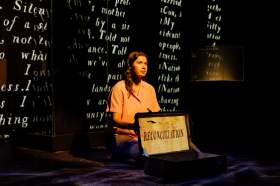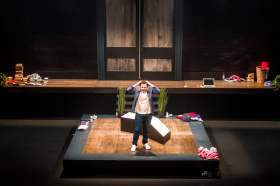Image: The Funeral Party. Photo Credit: Mona/Rémi Chauvin. Image courtesy Museum of Old and New Art, Hobart, Tasmania.
It was while navigating the death industry for her secular parents that artist Lara Thoms realised how stilted the Australian funeral industry was.
‘I found a gap in the industry for those who are creative – not religious and not elderly, which is the market that the sheer majority of funeral services target,’ said Thoms.
‘The funeral industry has several different brands that are owned by a single multinational organisation. This monopoly creates a lack of diverse funeral options,’ she added.
This experience led Thoms to further explore the industry through her art and she’s now received funding through the Creative State Commissions Program, allowing her to explore her ideas in depth.
In 2016 Thoms curated Dark Mofo’s Funeral Party – a gothic gala costume ball which aimed to demystify the experience of death. It was during this period that Thoms was introduced to funeral director Scott Turnbull, whom she said has an interesting approach to death and dying.
‘Whilst Scott had a traditional set up, he also did things like ride tractors into his chapel and build piers for people who were sailing enthusiasts. He created bold visual elements that felt really connected to the person, more so than a floral arrangement.’
Opening its doors to the public for a one-off event, ticketholders to the Funeral Party were able to experience a funeral home like never before, the results transformative for some.
‘At some points punters could have a tour of the crematorium with Scott and he was free to answer questions around the death industry that they were curious about,’ Thoms told ArtsHub.
‘There were a lot of artists responding with their own unique takes on death, dying and ritual, but it was also a party. There wasn’t a solemn atmosphere, which was interesting because a lot of the people at that party were locals who had been in that building in the past for an actual funeral service. And quite a few people came up to myself and Scott and said: “This is strange that I really feel like my grief has been transformed by this experience of celebration.”
‘People said: “I want my funeral to be like this. I don’t want it to be uptight and quiet. I want it to be exciting for the people who celebrate my life.”’
Her engagement with Turnbull has led to an additional two projects examining the death industry. One of those projects has received a $20,000 grant through Creative Victoria, allowing Thoms and her collaborators Sibling Architecture to explore the concept of constructing a place where people can develop and initiate their own creative funerals. Her project is one of seven to receive first stage funding. Projects which make it through to the final round will receive between $300,000 and $1 million to bring their creative ideas to fruition.
‘We think there’s a real lack of what is called “death literacy” in Australia, where we do shy away from talking about death and illness and from organising anything to do with end of life events or care. People don’t realise it is not essential to use a funeral director, or spend $5,000 on a coffin that is about to be burnt. There are choices to explore,’ Thoms said.
Re-imagining the use of space
One of Thoms’ visions for a creative funeral is a re-evaluation of how people come together.
‘When we talk about funerals we also talk about memorial services and wakes – the coming together of people; there might be speeches, catering and loved ones gathering to celebrate someone’s life. If not in a church, this often has to happen in spaces that feel uptight or operate as something else.’
‘Our idea is to create a space for these rituals, ceremonies or wakes that is contemporary, artistic and celebratory. Both a physical architectural space and also an online platform to talk about people’s wishes or intentions for their own funerals, which will inform the design,’ she said.
Through her research with Turnbull, Thoms discovered that a lot of the anxiety around planning a funeral for a loved one occurs because there’s been no prior discussion when it comes to the funeral choices on offer – something she would like to change, should her grant be successful.
‘Did they want something private and melancholic? Did they want something huge and celebratory? ‘Did they want to be cremated or buried? Being able to talk about what music you want played and what colours you want people to wear at a funeral might be some starting points,’ Thoms said.
The project will be pitched in May and the process, so far, has already afforded Thoms the opportunity to expand her vision.
‘Even having the time to research the creative possibilities and the feasibility of this idea has meant that we’ve met lots of great people working around death literacy who have found real interest in this idea,’ she said.
‘I feel like funerals, in a way, are extraordinary pieces of theatre. They share a lot of the elements that a performative event or a visual artwork can have. And there should be more options and understanding about what can be available because at the moment it’s poised that you have to make all of these huge decisions really quickly in a few days.’





